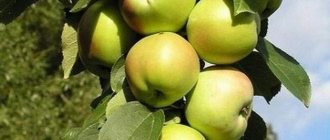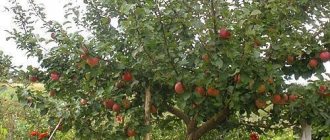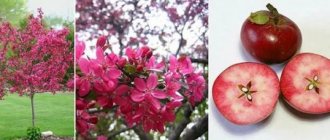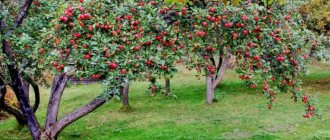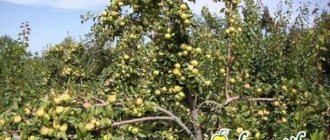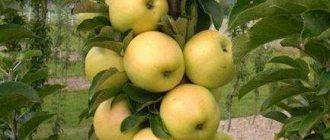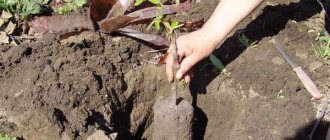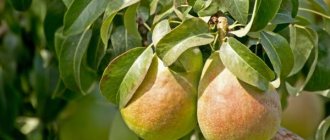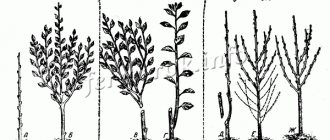Of particular interest to summer residents are small-sized apple trees that grow in one trunk, densely overgrown with fruit formations. Such varieties of the crop, in particular the “Valyuta” apple tree, which is columnar compared to varieties with a regular crown, provide earlier fruiting, ease of caring for the plant and harvesting very decent harvests.
“Valyuta” (pictured) is one of the best domestic columnar varieties with dessert-flavored fruits
We present the main characteristics of the columnar apple tree “Currency” in the table:
| Parameter | Characteristic |
| Culture | Apple tree (Malus domestica Borkh.) |
| Variety | "Currency" |
| Tree height | Medium height - 2-2.3 meters |
| Precociousness | High – in the 3rd year |
| Ripening time | End of August – first ten days of October (depending on the growing region) |
| Consumption (storage) period | Winter – until mid-February |
| Type of fruiting | Mixed: on spears and ringlets located on the trunk |
| Productivity of an adult tree per season | About 5-6 kg (80-100 t/ha) until 15-16 years of age |
| Size and weight of fruits | Large: from 130 to 240 g |
| Shape and color | Apples are round-conical, one-dimensional, regular in shape. The skin is thin, but dense with a slight glossy tint; The main color is light yellow, the cover color is in the form of an orange-red blush. Subcutaneous points are medium, gray and barely noticeable |
| Fruit pulp | White, juicy, prickly, fine-grained, medium density |
| Tasting assessment (taste qualities) | 4.2 points (out of 5) – the taste is sourish-sweet with a strong aroma |
| Purpose of fruits | Dessert (universal) |
| Sustainability | High winter hardiness (at the level of “Antonovka ordinary”). Frost-resistant. Average drought resistance; immunity to scab; sensitive to powdery mildew |
| Year of inclusion in the State Register of the Russian Federation | 2004 |
| Recommended growing regions | Central (3) |
| Originator | Federal State Budgetary Institution "All-Russian Selection and Technological Institute of Horticulture and Nursery Growing" (Moscow) |
We also invite you to watch a video presentation of the variety from Belarusian specialists from a fruit plant nursery located in the Vitebsk region:
Description of the columnar apple tree Currency
In Russia, the first columnar apple trees appeared by crossing the Korichnevoye Polosatoe and Vazhak varieties.
And the Currency apple tree is the result of many years of testing and testing. And it should be noted that the result is excellent. Read on for detailed descriptions, photos, reviews.
Apple tree “Currency” (columnar).
The variety was bred in 1986 by scientists and specialists of the All-Russian Selection and Technological Institute of Horticulture and Nursery Science under the leadership of V.V. Kichin and N.G. Morozova.
Since 1994 it has been in variety testing, and since 2004 in the State Register. We tested it for a long time! But he passed the test.
Harvesting apples "Currency" at the dacha.
You might be interested in:
- About the creator: Viktor Valeryanovich Kichina. Professor. The founder of two directions in the selection of fruit and berry crops. Creator of 30 varieties of apple trees. Since 1972, he has created 20 varieties of columnar apple trees. Most of them are winter-hardy and scab-resistant. Widely known and recognized varieties of large-fruited raspberries. There are 25 of them in total and are grown in more difficult conditions in Russia. Prepared a shift for myself - 32 candidates of science!
- About the variety: A low-growing tree with a small crown, which is only 20 cm.
- The dark green foliage that densely covers the trunk even falls off in the fall before it turns yellow.
- Round apples of golden color with a scarlet blush on the side are not uniform in size: Starting from 110-140 grams.
- And large ones weigh 230-250 grams.
additional characteristics
Advantages and disadvantages
all the best qualities of columnar apple trees in the Valyuta variety. And also:
- Very tasty and attractive for sale. They can even sit under the counter and on display for up to 2 weeks without any problems.
- Scab-immune variety with the Vf gene. More than 10 years of observation of the variety in the Moscow region confirmed its ability to resist this dangerous and widespread disease of apple trees. No cases have been reported! Just don’t think about juggling the results; this is confirmed by the description of the variety, photos, and reviews.
- The columnar apple tree variety Currency begins to bear fruit early.
- Productivity is high.
- Suitable for cultivation in central Russia without any problems.
Advice!
- Think about tree replacement ahead of time. After all, after 15 years there will be several apples on the tree.
- Write it down in your calendar: As soon as the trees are ten years old, plant a new garden of weeds .
- Consider replacement plantings. After all, I definitely liked the variety!
Dimensions of an adult tree
A naturally short, semi-dwarf tree. Even closer to dwarf. Therefore, even an adult tree is a little more than two meters . And their average height is 2.1-2.3 m. This also determines the annual growth . It's insignificant.
But if your tree grows 20-30 cm every year, then you take good care of your trees. And he's fine.
Frequency of fruiting
With a variety like Valya you will have to forget about the frequency of fruiting .
You are guaranteed to have problems processing and consuming fresh apples. Or rather, not problems, but pleasant concerns. You can even prepare a little drying. But fresh apples are better.
Productivity
You can often find that the main characteristic of columnar apple trees is their productivity. Not productivity.
And this is understandable. 5-6 kg of fruits from a mature tree is somehow not impressive. Not even a bucket. And the bucket. And the same 10 kg with good care. But for columnar apple trees this is a good yield.
But 100 tons per hectare is already a powerful argument. But it can be 150 tons with intensive care.
Important! Such productivity can be up to 14-16 years of age. The trees are then replaced with new plantings.
To set the mood:
- I once read that “cunning” gardeners manage to get large harvests. Than in the price lists.
- Sure! Not tricky ones, but real ones. Smart. Not lazy. Creative... You can continue further yourself.
Tasting assessment
- Dessert taste. And the sweetness is good. There is also sourness.
- But sweeter than the President and Vasyugan varieties (if you ate these columnar apples).
- And the rating is 4.5 points out of five. And that's a lot!
Self-fertility
There are judgments that the apple tree does not bear fruit:
- I don't think it's because it grows on its own . Although this is possible.
- My columnar apple tree has not produced fruit for more than ten years. Recognized pollinators grew nearby (I only found out later).
- This means that we still don’t know everything about columnar apple trees! There is something to work on.
Winter hardiness
even compare it with the famous Antonovka . And the comparison is not in Antonovka’s favor:
- They can withstand even 38 degrees of frost . This is a very high figure!
- That’s why they are grown in the difficult conditions of central Russia. And not only there.
- But there are columnar varieties with higher winter hardiness (for example, Vasyugan and Iksha). But this is not a reproach to Currency.
Disease resistance
Immunity to scab provides high resistance to other diseases. Especially to rot. But it is better to carry out preventive treatments .
Columnar apple trees in the garden.
Landing rules
Even if you are a novice gardener, you can easily cope with the task of growing this tree. You just need to do all the activities step by step.
Selecting a location
- For young trees, the most comfortable place will be light shade, areas with diffused lighting. Since places with drafts and cold winds are not suitable for apple trees, it is better to plant seedlings along buildings or fences.
- Apple trees tolerate transplantation well, so adult plants can later be transplanted to a sunny area when they gain strength and become stronger.
Preparing for planting
Purchase a seedling first. It is better if it is an annual or biennial tree. Inspect the root system and branches carefully. There should be no dried or rotten areas or damage to the bark. Before planting, immerse the root system of the tree in warm water for 15-16 hours, where you add a growth stimulator according to the instructions.
- The hole circumference is 60 - 80 cm - this size is more suitable for the root. If the soil is clayey, then make the hole about 1 m deep so that there is room for a drainage layer. Crushed stone, river sand or broken brick will do.
- If there are several seedlings, then the gap between the pits should be at least half a meter, and between the rows 1 m.
- Mix the bottom layer of soil that you dig out of the hole with fertilizers: 3 - 4 kg of organic fertilizers (humus, compost), 80 g of potassium, 100 g of superphosphate.
- Pour the prepared soil mixture into the bottom of the planting hole and then leave it for 4 weeks for the soil to settle.
Landing
- Some gardeners plant using the warm bed method. Closed plastic bottles are placed at the bottom of the hole, and layers of grass, organic waste, paper, and cardboard are placed on top. This way the cold will not penetrate the root system.
- A wooden peg is driven into the formed earthen lump, and a young tree is installed nearby.
- The root shoots must be well straightened and then the soil must be filled. You should not allow voids to appear in the root system.
- After planting, compact the soil. Make sure that the root collar is located several centimeters (3 - 5) above the soil level.
- Water the seedling with 20 liters of water. It is necessary to moisten the soil several times every 7 days if it is hot outside. Timely watering is important precisely in the first year after planting a tree, while it is taking root.
Mulching the soil will help, which will help retain moisture and prevent the appearance of weeds. In winter, the summer layer of mulch must be removed to prevent rodents from appearing near the seedling.
Reviews
Sergey Karasev: After the appearance of the first columnar apple tree, I was carried away. I wanted to plant more and more. This is despite the fact that you can’t take boxes and buckets of apples from them. But how beautiful they are in the garden. I recommend it. Planting is not just for the sake of having it in the garden. And so that it decorates your garden. To be visible. This is how Currency appeared in the garden. This variety further fueled my desire to plant and grow them.
Maxim Egorov: Apple tree Colon The currency suits me completely. Do whatever you want. I created a unique row near the fence. Beautiful. And also with very tasty apples. Experimented with their ability to persist. Just in the cellar. They remained good in February. And juicy.
Stepan Okrainsky: I’ve heard a lot of stories about the fastidiousness of columnar apple trees. And the soil needs to be fertilized. And water more often. Drip irrigation solved almost all my problems. And the taste of late apples convinces Valyuta to plant a couple more of these. Or maybe a different kind. But winter ones. The look and size completely satisfies me. The taste is excellent. Especially in February.
Planting a columnar apple tree.
Advantages and disadvantages of the variety
It is obvious that, in comparison with tall, spreading apple trees, columnar forms are superior in many respects. Based on the conclusions of summer residents and professional gardeners, the main positive features of the variety are:
- short stature of trees, which makes it easy to pick fruits from them;
- high productivity;
- small size and decorativeness of apple trees;
- resistance to frost, pests and diseases;
- good keeping quality of apples;
- excellent taste and presentation;
- the versatility of apples (suitable for eating raw and for home canning in all forms);
- easy care (no need for pruning or spraying).
Among the shortcomings, perhaps the only quality is a decrease in yield after 15-16 years of life. This forces gardeners to rejuvenate their plantings, since the ringlets on old apple trees begin to dry out from below, and the trees become barren. It is not possible to stimulate fruiting by pruning branches, as on ordinary apple trees.
In large areas, it is recommended to uproot ten-year-old plants, replacing them with new seedlings. Moreover, this procedure is not done immediately throughout the entire garden, but in parts to avoid a decrease in the yield.
How to plant and care
Deadlines
As soon as spring comes, I want to plant trees . So drop off the Currency:
- For her, spring is preferable . Manages to get stronger by winter.
- Provide sunny or slightly shaded places for it.
- Pay attention to groundwater . Their high location is unacceptable.
Technology
Anyone who has planted at least one tree considers himself an expert in planting trees. And rightly so.
Attention! Follow the recommendations of specialists and then you will have more guarantees in the successful planting and survival of the seedling.
Just a few nuances:
- Choose a planting site, which you definitely did before you buy an apple tree.
- Select healthy seedlings. Better with a closed root system.
- Prepare planting holes (or trenches when planting a large number of trees). In autumn for planting in spring. Or 20 days before landing. Their size should ensure free placement of the roots. No twists or bends. Fill them with fertile soil and fertilizers.
- The grafting site should be 6-8 cm above ground level.
- Insert a stake and tie up the seedling.
- Don't forget to water and mulch thoroughly.
Distance
There are many planting options. And it’s not just the availability of space and area that determines this. We talked about their magnificent decorative appearance. Anyway:
- There must be at least one meter between rows.
- 40-50 cm in a row is sufficient.
Features of columnar apple trees.
Features in Siberia
The weather conditions of Siberia oblige you to pay more attention to all stages of planting and growing an apple tree.
Eg. Same cut. Freezing of branches more and more often. But they have a good ability to recover. And the presence of snow allows for better cover.
Advice! In general, I would not undertake to advise Siberians and Urals on how to grow apple trees in their country.
Agricultural technology
Includes the above-mentioned selections of location, planting dates.
And also a number of agrotechnical actions . Regular watering and fertilizing for a columnar apple tree are of great importance. The high location of the root system obliges you to carry out them regularly:
- Water twice a week (if summer is dry).
- Feed . Organic and mineral fertilizers. Just like during the growing season. The same is true when fruits ripen. Top dressing can be root or foliar.
- Loosen and mulch . After watering. But don't overdo it. Remember your roots.
- Sow with cereal plants.
- Protect from pests and diseases. Even immunity to scab requires preventive treatments against diseases in early spring and autumn. And the pests themselves will remind you of themselves. Treatments can be carried out with compatible tank mixtures of insecticides and fungicides.
- Including from rodents . Or whatever you want to call the bunnies. The crown of columnar apple trees is very vulnerable and tasty to bunnies.
- Prepare trees especially carefully for winter. And they are a serious test.
Trimming and shaping
Included in the complex of agrotechnical techniques for caring for apple trees . Many people believe that a columnar apple tree does not need to be pruned. That's why they buy them.
This is a misconception. The shape of the column (or pyramid) is precisely what pruning allows you to preserve:
- Leave 2-3 buds from the side shoots .
- Next year two shoots will grow.
- Leave the more horizontal one.
- And cut the second one again into 2-3 buds .
- The next year, remove the fruiting branch.
- And with two escapes the actions are repeated.
Trimming diagram.
- Moreover, it is necessary to remove damaged and dry ones.
- And don't forget about the apical bud . Even take care of her. Its preservation will be ensured by its columnar shape. Damage to the bud leads to the growth of 3-4 shoots. Your task is to leave one of them. And then do this every year.
- And if you miss this moment and leave a few of them, grow a dwarf tree with a pyramidal crown. And you will increase your productivity.
Columnar apple trees planted along the fence.
Rootstock
You can purchase this :
- In the regions of the South - Paradise Belorusskaya (PB-4).
- In central Russia - Baby Budagovsky.
- This means they will grow up slowly, without haste.
Important! Due to their natural affinity for dwarfs, it is not advisable to graft them onto low-growing rootstocks. Because they will be small. As you can see, they vaccinate and sell.
Pollinator varieties
For good fruiting, use varieties with similar ripening periods. And these are late autumn or winter varieties.
Specifics of cultivation
In reviews of the columnar apple tree “President”, the variety is called relatively winter-hardy. However, it is not very suitable for cold regions, since roots located close to the surface may freeze out.
In autumn, it is recommended to cover the soil in the tree trunk circle and wrap the lower part of the trunk to protect it from rodents and frost.
Landing
It is advisable to plant apple trees in the spring, in places protected from the wind. The distance between seedlings in one row should be about 60 cm, between rows - 90-100 cm.
For planting semi-dwarf columnar apple trees, a place next to a path or fence is well suited.
Preparation of the planting hole largely depends on the type of soil:
| Soil type | Dimensions and features of the landing pit |
| Chernozem | Diameter and depth up to 60 cm |
| Clay or loam | The pit can be made shallower, but the width should be up to 1.5 m, so that it is easier for the roots to develop in breadth |
| Sandstone | Diameter 60 cm, depth up to 1 m; clay is placed at the bottom to retain moisture |
Watering, fertilizing and pruning
The plants are moderately resistant to drought and love moisture, so in dry weather it is advisable to water the trees 2-3 times a week: due to the specifics of the root system, it is difficult for them to extract water from the deep layers of the soil.
During formative pruning, annual shoots are pruned at a distance of two buds from the trunk
Fertilizers for columnar varieties of crops are applied in quantities reduced by 10 times compared to the usual rate.
When loosening and compacting the tree trunk circle, extreme care must be taken so as not to damage the roots. Pruning is carried out both sanitary and formative in order to thin out excessively dense growth
Pests and diseases
The “President” variety is resistant to a number of fungal and bacterial diseases, but it requires treatment against scab, black cancer, powdery mildew and mosaic.
Of the insects that can harm the plant, the codling moth, Schlechtendahl mite, aphids, leaf rollers, and fruit moths can harm the plant. To avoid this, you need to spray the trees with insecticides in a timely manner.
The codling moth is one of the main crop pests
Thanks to the compactness of the plant, the early start of the productive period, fairly high yield and the pleasant taste of the fruit, the President apple tree will be an excellent choice for a garden or summer cottage - especially a small one, where saving space is important.
Features of ripening and fruiting
What year does it bear fruit?
Currency is a leader in early fruiting even among columnar apple trees. An annual seedling planted in spring may bloom in May.
Experts do not recommend leaving flowers for fruit formation . So that the apple tree gets stronger this year. And she gave her strength to the fruits. They will come later.
Columnar apple trees Currency and Moscow necklace.
Ripening time
It is a winter variety and ripens in its own time - early October . If something didn’t work out for you with the removal of the fruits, you don’t have to worry. Apples don't fall off for a long time. Even ripe ones.
Features of fruiting
Consists of regulating flowering and ovary formation:
- First year of planting - remove all flowers
- Second year - leave 6-8 set fruits.
- In the future , leave 2-3 flowers on the fruit link.
- Of the formed ovaries, leave only one.
Important! Adult fruiting begins at 5-6 years and up to 14-16 years.
Shelf life
Your usual storage conditions in basements will ensure their long-term preservation. Until February.
If you want to eat on March 8, take care of improved storage conditions.
Annual seedlings of a columnar apple tree in the garden.
Aftercare for the apple tree
In the first year, the apple tree is watered 1-2 times a week; the roots of the Valyuta variety are strong and quickly accepted.
From May, every 3 weeks, you need to feed the seedling. Organic fertilizers are used for this. To ensure dense flowering and ovaries, potassium-phosphorus fertilizer is used per 1 sq.m. accounts for 40 - 60 gr.
In the second year, the side branches and excess ovaries on the seedling are cut off, the latter remaining in the amount of 5–6 pieces. This process preserves the development of the root system. Every year, several buds are removed from the fruiting branches.
Before frost, a young apple tree is treated with a chalk solution and covered with spruce branches. The adult trunk of the Currency is whitewashed with lime mortar, then covered with spruce branches, sawdust, and fallen leaves.
Diseases and pests, methods of control and prevention
Columnar apple tree disease can be prevented by preventive spraying. This process is carried out in early spring or late autumn, when the harvest is harvested. For this, Bordeaux mixture or a solution of the drug Nitrofen is used.
Rodents tend to eat the trunks and roots of the columnar variety. For protection purposes, the lower part of the trunk should be wrapped in paper, straw, roofing felt, spruce branches, and scraps of fabric soaked in creolin.
Features in regions
In outskirts of Moscow
All of the above applies precisely to the Moscow region and North-West Russia.
In Siberia and the Urals
Columnar apple trees are becoming increasingly popular here:
- Their frost resistance is among their priority qualities.
- The columnar apple tree Currency is not just included in the list of varieties that can be grown in these harsh regions . She occupies a leading position.
- And if we take into account the possibility of growing them in flowerpots , this opens up additional prospects. Not only for Currency.
Nuances and questions from readers
What to do if it doesn't bear fruit?
This is what happened to me.
But the variety of columnar apple tree is different. What I did:
- Barrel constrictions.
- Driving nails into the trunk.
- Threats with an axe.
- Increased attention to care (especially more watering and fertilizing).
- Apples have appeared. What specifically helped? Don't know. And there are many more options (root system, even errors with the variety).
How to plant an apple tree correctly
Many people believe that if a tree is undemanding in care, then planting it is no different from other plants. But it soon turns out that neglecting the rules for choosing a place and rooting seedlings affects the quantity and quality of fruits.
The key to success in gardening, of course, is a healthy seedling with a strong rhizome without any damage. The development of the apple tree during the first ten years depends on its quality, and in the case of columnar specimens, this is the period of intensive fruiting.
